
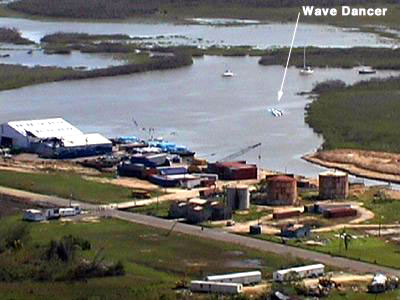
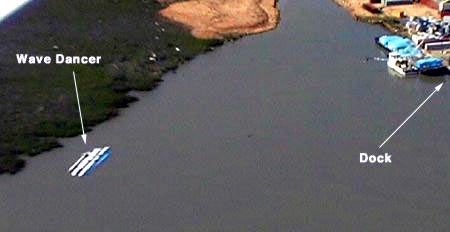
As for the MV Wavedancer, she remains moored along the mangroves of Big Creek, apparently the only memorial to a disaster that authorities seem determined to forget.
Source:
Channel 5 Belize
Channel 5 Belize
But why does the IMMARBE Report fail to hold Peter Hughes equally accountable for his actions? He is, after all, the Tour Boat Operator who hired an incompetent Captain, did not provide adequate maintenance or equipment for the Wave Dancer, and neglected to supervise the operation of the vessel when it was in danger.
Apparently, Belize's Attorney General (and Minister of Information), the man who oversees IMMARBE, the police. and the Department of Public Prosecution, is not willing to indict Peter Hughes, who brings hundreds of tourists and millions of dollars to the Belizean economy each year.

- The RDC survivors of the Wave Dancer accident, Mary Lou
Hayden, Rick Patterson, and Dave DeBarger, each created a chronology of
the night of the
accident shortly after they were rescued on October 8, 2001.
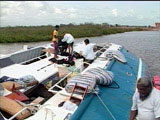
- Those hand-written statements were given to Peter Hughes when he arrived in Belize following the accident.
- These same statements were
never handed over to IMMARBE or requested by any Belizean official.
Eventually, photocopies of the documents were sent to the survivors by
mail.
- IMMARBE sent each RDC survivor a list of questions pertaining to their investigation.
- The survivors provided detailed answers to each of the questions, and gave those document to Ken Paciocco, their attorney, to hold until after the settlement of the lawsuit against Peter Hughes.
- Attorneys for the
vicitms' families and survivors were
concerned that any statements made prior to the settlement of the
lawsuit might be used by Hughes'
lawyers to make a case for partial responsibility, thereby reducing the
amount of any judgement awarded to all of the plaintiffs
- IMMARBE received the statements from the three surviving passengers on 27 February 2003.
- Angelou Mouzouropoulos, Director-General of IMMARBE, stated
in a letter to the survivors that:

"(their)
statements threw new
light on at least two issues... that IMMARBE completed the Draft
Casualty
Investigation Report on 28 March 2003, and that IMMARBE then circulated
the draft report to those persons criticized therein and was awaiting
their rebuttal before finalizing the Report. "
- During this time, Peter Hughes Diving, Inc. filed a lawsuit against the Aggressor Fleet, claiming that the Belize Aggressor III had collided with the Wave Dancer and caused Wave Dander to break from its moorings.
- IMMARBE immediately put a hold on their report pending the outcome of that lawsuit.
- IMMARBE released the final report in January 2005, shortly after Peter Hughes dropped his lawsuit against the Belize Aggressor.
Source:
Channel5 Balize
Channel5 Balize
Dave
DeBarger
IMMARBE
IMMARBE
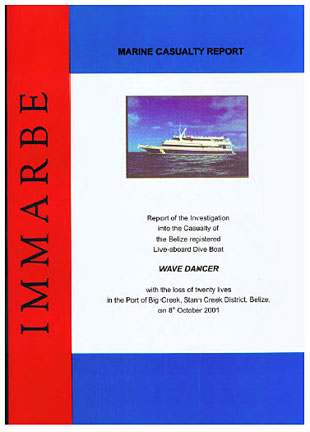
An abridged version of the report appears below. For the complete report click here (2.9 MB).
Report of the
Investigation Into the Casualty of the Belize registered Live-aboard
Dive Boat
WAVE DANCER
with the loss of twenty lives in the Port of Big Creek, Stann Creek District, Belize, on 8th October 2001
International Merchant Marine Registry of Belize
Report No. 1/05
Issued January 2005
WAVE DANCER
with the loss of twenty lives in the Port of Big Creek, Stann Creek District, Belize, on 8th October 2001
International Merchant Marine Registry of Belize
Report No. 1/05
Issued January 2005
1.1 The Purpose of the Investigation
This casualty is investigated by the International Merchant Marine Registry of Belize (IMMARBE) and is published in accordance with the IMO Code for the Investigation of Marine Casualties and Incidents promulgated under IMO Assembly Resolution A.849(20). The purpose of this investigation is to determine the circumstances of this casualty in order to avoid similar incidents in the future. The conclusions drawn in this Report aim to identify the factors which contributed thereto. They are not intended to apportion blame between or to determine the liability of any of the organizations or individuals involved except so far as is necessary to achieve the said purpose.
16th July 2003, we were informed that lawyers representing the insurers of the Wave Dancer had commenced legal proceedings against the Owners of the Belize Aggressor III alleging that the casualty to the Wave Dancer had been caused by a collision between these two vessels which had allegedly occurred due to the fault of the Belize Aggressor III. This led to our having to examine further evidence.
6.9 The following decisions were taken by the Captain:
6.9.1 To sail from Radisson Fort George, Belize City at 17:00 hours on 6th October.
6.9.2 To allow the guests to dive at Half Moon Caye on Lighthouse Reef from approx. 08:30 hours to about noon on 7th October.
6.9.3 To allow the guests to dive at Long Caye on Lighthouse Reef from approx. 14:00 hours until 18:00 hours on 7th October.
6.9.4 To allow the guests to dive at Long Caye on Lighthouse Reef from approx. 20:00 hours until 21:00 hours on 7th October.
6.9.5 To inform the guests on the evening of 7th October that he intended: "to proceed South to Big Creek to seek shelter in order to be well away from the forecast landfall of the storm" which according to his statement: "was expected to hit the Yucatan Peninsula of Mexico on late Monday October 8th."
6.9.6 To remain at the atoll on Lighthouse Reef on the night of 7th October.
6.9.7 After listening to "Belize Radio forecast" at 06:00 hours on October 8th in which, according to the Captain's statement, "they stated that Tropical Storm Iris had been upgraded to hurricane status Category 1 and was expected to hit landfall between Dangriga and Belize City. I prepared to depart for Big Creek. At the same time an RAF helicopter flew over us with a sign "hurricane." We departed at 06:30 hours….."
6.9.8 The Captain stated that "at 06:40 hours, I called Charles Vernon, our agent in Belize City and informed him of my intended itinerary and asked whether he wanted us to proceed to Belize City." Charles Vernon informed the Captain that there was: "nowhere to accommodate the guests there because Belize City was being evacuated." The decision to proceed to Big Creek was therefore agreed.
6.9.9 During the voyage to Big Creek, the Captain: "instructed the crew to secure the vessel in accordance with the Hurricane Plan Procedures." He also contacted Peter Hughes Inc. Miami on two occasions by satellite phone and informed them of his intentions to proceed to Big Creek to which they agreed.
6.9.10 At Big Creek, he decided to secure his vessel at the dock, Port Side to, in front of the Belize Aggressor III, and according to him, leaving a gap of between 10-15 ft. between the two vessels. "We put on extra mooring lines, a total of between 12 and 14 lines ranging between 1" and 2" in diameter." He stated: "Thereafter I spoke to Captain Jerry of Belize Aggressor III and discussed our lines and ensured that there was enough slack (10ft to 15ft) in the lines for the potential storm surge. I inspected my vessel to ensure that all was tied down securely."
6.9.11 With regard to the decision to remain on board, the Captain stated that: "at approximately 16:30 hours, Mr. John Barillas, Port Security Guard, acting on his own initiative, came to my vessel, and informed me and my guests that he had heard that we might be able to be accommodated at the Bank. I enquired as to what facilities (toilets, food, sleeping accommodation) were available at the Bank for my guests and he replied there were none. He did not inform me or my passengers of any pre-arranged method of transportation to the Bank. Christyn McNeil, a guest, took a poll of the passengers and they voted to remain onboard in the same way as the guests of the Belize Aggressor III had decided. Glen Prillaman also decided we should remain on the boat on behalf of the passengers. No other shore based official came to the vessel thereafter." The "Bank" is a building in the nearby village of Independence.
6.9.12 The Captain decided to check the lines at 19:30 hours when the winds rose to hurricane force. He "found them to be secure." "We taped all windows at approx. 20:00 hours and informed all guests to remain in doors and where they were. The majority of the guests were in the salon."
6.9.13 At approximately 20:30 hours the Captain "went to the main deck to check the lines." He stated: "I encountered hurricane force winds and corrugated roofing on deck. There was some structural damage to the boat stanchions for the handrails astern. Visibility beyond our vessel was zero. I proceeded to the main salon and instructed the guests to remain in place because of the risk of flying debris outside. There was no other perceived danger to the safety of the vessel or to any of the passengers at this point."
The following additional information should be noted:
- In his evidence, 2nd Captain Wouters has stated to us that "The Captain informed the guests at the time of the pre-night dive meeting that he intended to proceed South on Monday, October 8th to be well away from the forecasted landfall of the storm." In a subsequent statement to us, after further questioning by us, 2nd Captain Wouters has also stated that "on the evening of October 7th after dinner I had become increasingly concerned about the hurricane and believed the best and perhaps only thing to do was go to Belize City. Captain Martin had gone to his cabin just behind the wheelhouse immediately after dinner. I knocked on his door. I told him I believed it was best to go to Belize City immediately. I attempted to persuade him that we could drop off the passengers at a hotel and we could take the boat to an area deep in the mangroves with just a skeleton crew. He rejected the idea. I returned twice more. Each time the discussion became more heated until we were both shouting. This is the argument I believe several other people heard. It was a major disagreement that ended only when Captain Martin informed me that he had made the decision to remain where we were for the night and go to Big Creek the next morning and slammed the door." There was no reference to this incident in Captain Martin's statement and he has not denied that this had occurred in subsequent correspondence with us.
- In relation to 6.9.5, in his statement Bartholomew Stanley - divemaster and photographer - stated that on the evening of 7th October: "...apart from being a divemaster, I am also a relief second Captain, got in touch with the American, Captain Frank. I then told Captain Frank that in a situation like this, I know that the vessel would be taken back to Belize City. The guests would be taken off along with the crew and sheltered in a safe place. The Captain then along with two other crew members would take the vessel to the lagoon at Big Creek for safety." "Captain Frank then called over Captain Phillip Martin and relayed the same information I gave him in my presence. That we must take back the guests to Belize, inform their families and put them in a safe place. Captain Martin response was that we can't do that. He must get in touch with the office in Miami, Florida and the shore agent Mr. Vernon in Belize City as to the safety of the guests. Captain Frank then told Captain Martin to put the guests at Fort George Hotel. Captain Martin response was putting guests at hotels was not in the plan. Captain Frank told Martin it should be. Captain Martin then mentioned that the guests had already paid their money and he will see how the weather would be the following morning and what would be the latest on the weather fax. Captain Frank then told Captain Martin that in cases like Hurricane Iris, he must take charge and make his decision. The Captain did not make any decision so the vessel remain moored in the lagoon at Lighthouse Reef."
- In relation to 6.9.5, in her statement Angela Luk, Assistant Cook, confirms Bartholomew Stanley's statement about the meeting with Captain Martin on the night of 7th October: "...we went to speak to Captain Philip Martin and Eloisa told him that in the case of hurricane Mitch, the vessel returned to Fort George Marina and dropped off the local crew and any guest who wanted to get off as well. He replied that if we let you three go who will cook and clean the cabins? We went to bed. Some time after 23:00 hours that night, the Captain sent Bart Stanley to wake us up to secure everything in the kitchen. He said that we might leave tonight to go to Big Creek or Belize City. We went back to bed again."
- In relation to 6.9.10 above, after correcting an earlier verbal statement that it was 6 ft., the Captain stated that the slack on the mooring lines was 10ft. and after the statement was submitted to him for signature, he amended it to 10 – 15 ft.
- In relation to 6.9.10 above, the 2nd Captain Frank Wouters stated: "We secured port side to in front of "Belize Agressor III with our bow protruding some 25 –30 ft beyond the dock and secured with 12 – 14 lines (2" – 1" diameter, the latter quadrupled). I put sufficient angle on the lines to compensate for an anticipated approximate 10 ft. surge in a hurricane situation."
- In relation to 6.9.10 above, Dive Master Bart Stanley stated that the distance between the stern of the Wave Dancer and the bow of the Belize Aggressor III was less than 6 ft. Also, the slack in the ropes varied at about 8-10 ft. maximum. Furthermore, at the time of mooring, he had personally left about 8ft. slack in the mooring line securing the port aft mooring bitt to the dock. Thereafter, some of the lines had been re-arranged.
- In relation to 6.9.10 above, the Master of the tug boat Miss Gayle stated that the distance between the stern of the Wave Dancer and the bow of the Belize Aggressor III was less than 6ft. Furthermore, that the Wave Dancer broke away from her moorings about when the surge had reached its height somewhat in excess of 6 inches above the dock.
- In relation to 6.9.10 above, one surviving guest, Mary Lou Hayden, has stated that the distance between the stern of the Wave Dancer and the bow of the Belize Aggressor III was "about 3 ft."
- In relation to 6.9.10 above, Captain Jerry Schnabel of the Belize Aggressor III has stated that the distance between the stern of the Wave Dancer and the bow of the Belize Aggressor III was 15 ft – 20 ft.
- In relation to 6.9.11 one surviving guest, Mary Lou Hayden, has stated: "I was never asked nor did I take part in any discussion to leave the boat and take shelter in the bank building."
6.11.4 According to the "Mooring Arrangement" diagram signed by the 2nd Captain Wouters (Attachment 6), the boat was secured by 11 mooring ropes ranging between 1" and 11⁄2" in diameter. Eight were made of nylon and three of polypropylene, two of which were quadrupled. Both Captain Martin and 2nd Captain Wouters had stated that there was some 10 – 15 ft between the stern of the Wave Dancer and the bow of the Belize Aggressor III. There is a divergence between the Statements of Captain Martin and 2nd Captain Wouters as to how much slack there was in the mooring lines – the former stated after 2 corrections that it was 10 – 15 ft whereas the latter maintained that it was 10 ft. Also, Dive Master Bart Stanley stated that the slack in at least one rope was about 8ft.
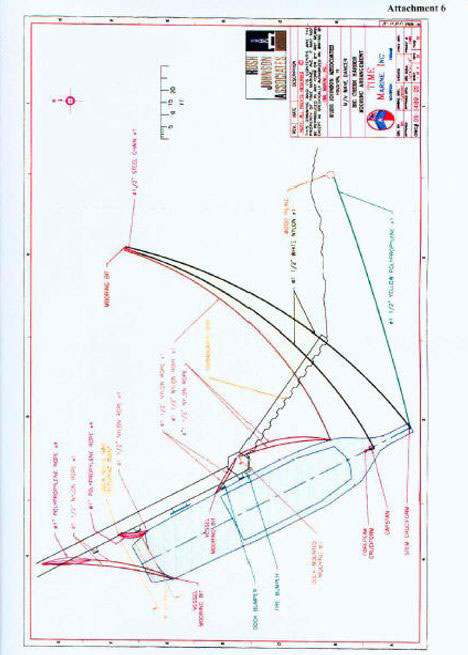
According to Earl Young, Captain of the tug boat Miss Gayle minutes before the casualty: "when the wind shifted to the Southeast the Hurricane then came in much stronger. I believe in the maximum strength that it was coming with rain and the water started to raise about 6 inches over the dock." "I would go down into the kitchen of the tug and look through the window and see the water raising…."; "….I notice the boat Wave Dancer which was tied to the dock with the stern out from the dock and the bow facing the wind, which I then believe had its stern rope burst away, this time not even more than thirty seconds I notice everything burst away from the boat, which started to drift to the mangroves and thereafter I didn't saw anything it just disappear."
After being blown off the dock, stern first, the Wave Dancer had drifted quickly across the channel towards the mangroves, grounded, rolled over and flooded within what was described as "seconds".
The 17 guests and the 3 crewmembers who perished were all in the salon area. According to Bart Stanley, the Dive Master, "the guests from the starboard side were thrown violently to the port side." Out of the survivors, Bart Stanley was the only one near the salon area: "I was under water and felt trapped." "Since I knew the boat very good I swam trying to find a way out. I then came across the Starboard exit door facing the wheelhouse." Also, according to Captain Martin, after the boat capsized he "swam to the surface, then dived back down to try to open the salon door, but could not open it."
6.12.5 In the village of Independence, next to the port of Big Creek "seventy percent of the buildings had their roofs blown away", the 3 and only hotels all had their roofs blown off and one of them had lost its 2nd floor, there were telephone poles lying in the street, the bank building had a pole through its roof. "Other coastal towns such as Placencia were very badly battered resulting in the loss of many houses rendering some 13,000 people homeless. Also, pine forests and banana plantations were seriously damaged".
Nevertheless, the only persons who lost their lives due to Hurricane "Iris" were the 17 guests and 3 crew on the Wave Dancer.
7. CONCLUSIONS
7.4 The Wave Dancer's Manning
We are satisfied that the Wave Dancer was adequately manned with a qualified crew onboard at the time of the casualty. However, it should be noted that both Captain Martin and 2nd Captain Wouters had little or no prior experience of sailing in Belizean waters during the hurricane season. Nevertheless, the Divemaster Bart Stanley, who had also acted on at least one occasion as relief 2nd Captain, had several years' of such experience.
7.7 Monitoring of Weather forecasts/advisories
Despite the clear instructions given by Captain Alan Cull of Peter Hughes Diving Inc to Captain Philip Martin both by phone and by email on 5th October to closely monitor the storm, we conclude that Captain Martin failed to do so on Sunday, 7th October in that:
The Captain, in his evidence to us, advised us that he was not aware of the three NEMO Declarations which were mirrored in the National Hurricane Centre's Miami Advisory 12A at 2pm EDT (noon Belize Time), Advisory Number 13A issued at 8pm EDT (18:00 hours Belize Time) and Advisory 14 issued at 11pm EDT (21:00 hours Belize Time) nor to the numerous General Weather Forecasts and Marine Forecasts issued on local radio stations.
... the Captain stated that the Belize Radio forecast on 8th October at 06.00 hours had upgraded the "tropical storm to hurricane 1 status (refer to 6.7.6 above) whereas in fact, that weather forecast had upgraded it to a Category 4 hurricane (refer to 6.6.6 above). If the Captain and 2nd Captain had closely monitored the weather forecasts and Advisories, they would have known. Furthermore, the Captain had failed to clearly define the responsibility for monitoring the weather and for ensuring that he was aware of the latest weather information. In answer to our criticisms concerning the monitoring of weather forecasts, 2nd Captain Wouters stated to us "I was never directed to do any of this by Capt. Martin nor did he ever say I was solely in charge of weather information. I attempted to gather as much information as possible out of my own concern for the passengers, the crew and the vessel."
7.8 The Hurricane Plan
- On Sunday 7th October, the Captain failed to comply with the Hurricane Plan which required him to "contact shore manager – advise boats plan and liaise with, for current forecasts etc as local knowledge and experience in dealing with hurricane in this area cannot be underestimated." There is no record or mention of any communication between the Captain and/or 2nd Captain with the agent Charles Vernon in Belize nor with any of the staff of Peter Hughes Diving Inc in Miami on Sunday, 7th October. However, the Captain has stated to us that he had tried to contact Charles Vernon but had not succeeded in doing so. Charles Vernon as well as the other Peter Hughes personnel in Miami all have denied receiving any messages from Captain Martin either directly or on any answering machines. Furthermore, neither the Captain nor the 2nd Captain listened to the local Belize radio stations themselves and were apparently satisfied with receiving morsels of such information from their catering staff.
- Wave Dancer (Belize) Ltd who were described by Owners' representatives as the operating company whose employee in Belize, Mr. Charles Vernon, acted as agent of this vessel was and should have been aware of the 3 NEMO Declarations issued on Sunday 7th October as well as the Weather, Marine and other broadcasts made on the radio stations in Belize on that day. Not having heard from the Captain, the Agent should have initiated contact with the vessel in order to acquaint himself with its whereabouts and the Master's intentions in view of the weather forecasts as well as to advise him in relation thereto.
- We are satisfied that the Captain did order the crew to secure the vessel in accordance with the Hurricane Plan Procedures on the voyage to Big Creek. However, we would remark that the taping of windows in accordance with the hurricane plan procedures was not completed until about 20:00 hours, approx. half an hour after the hurricane made landfall at Big Creek.
- The Captain did not comply with the requirement of the Hurricane Plan by failing to supply guests, inter alia, with flashlights and to instruct them to "remain with life jackets" and "remain on the floor" in accordance with the hurricane plan. Although life jackets were available on the main deck, attached to the deck head of the deck below, they clearly could not be reached in time in the event of a casualty such as the one which occurred. We do not accept the Captain's attempted justification that: "Never in my wildest dreams would I have thought the boat could possibly capsize whilst tied to the dock" because:
The weather forecasts had
indicated that "Iris" was a Category 4 hurricane and that the storm
surge on the coast would be 13-18 ft. Although approx. one mile from
the coast, the Wave Dancer could have been subjected to a substantial
surge of about 12 ft.
Vessels can break their moorings
or become damaged by other vessels or objects in such weather
conditions for a number of reasons and the necessity to use life
jackets cannot be excluded.
7.9 Voting by GuestsThe polling which took place of the guests on the afternoon of 7th October as to whether or not to return to Belize City with a view to being accommodated ashore or to stay on the boat and proceed South could not have been based on any better knowledge of the weather situation than that which the Captain and/or 2nd Captain possessed regarding several important developments. Furthermore, voting by guests is nothing more than an indication of their preferences but not a means by which a Captain arrives at his decision with regard to safety matters.
7.10 The Captain's decision to remain at Lighthouse Reef on the night of 7th October
Although there is no specific reference in the Captain's statement to a difference of opinion between himself and the 2nd Captain on the evening of Sunday 7th October, we do give weight to the statements of 2nd Captain Wouters, Bartholomew Stanley – Divemaster and Angela Luk - Assistant Cook in this regard. We accept that the latter two Belizeans, having heard the broadcasts on a Belize radio station earlier on that day and having more experience than both the Captain and 2nd Captain with hurricanes in Belize, should show concern and wish to disembark the guests and themselves. We also accept that the 2nd Captain Wouters had expressed the same opinion to the Captain. Furthermore, it was evident by their demeanour during the submission of statements by both the Captain and 2nd Captain that some serious disagreement had occurred between them during this voyage. As the result of the Captain's decision to remain at Lighthouse Reef on the night of Sunday 7th October based on his mistaken belief that "Iris'" landfall was still projected for the Northern Yucatan Peninsula of Mexico on late Monday 8th", the opportunity to land the guests at Belize City prior to its evacuation was missed. Belize City was approximately 5 hours steaming distance from Lighthouse Reef and could have been reached on the evening/night of 7th thus enabling the evacuation of passengers and non-essential crew. Furthermore, this would have allowed sufficient time for the Wave Dancer to be taken from Belize City by a skeleton crew to a suitable place of refuge such as Big Creek prior to Iris' landfall on the 8th PM.
7.12 The Wave Dancer's Mooring Arrangements Whereas the condition of the mooring ropes is considered satisfactory, the place where the vessel docked at Big Creek as well as the Mooring Arrangements (Attachment 6) were unsatisfactory:
- The bow protruded beyond the dock by over 30 ft thus exposing the section of the vessel to the hurricane winds. As events transpired, it is unlikely that this less than satisfactory mooring position caused the loss of the Wave Dancer, as the storm surge was so high as to lift its deck above the height of the dock thus exposing the entire windage area of the boat to the hurricane winds and not just the exposed bow.
- The existence of mixed moorings, nylon and polypropylene - the polypropylene ropes would take all the loading due to their respective stretch characteristics – polypropylene has only 10% whereas nylon has 30%.
- There were no effective aft spring lines to prevent the vessel from moving aft.
- The quadrupled polypropylene rope leading from the Port Quarter, while looking to provide strength, was short in length and received much of the strain, particularly in view of the direction of the very strong offshore wind as well as the effect of the surge thus resulting in the aft Port Quarter mooring bitt failure.
- We have already commented on the Wave Dancer's unsatisfactory mooring arrangements under 7.12 above. We have concluded that it had no effective spring lines to prevent it from moving aft for the following reasons:
- The "back spring" was too short and failed to run parallel with the boat for a distance sufficient to provide good protection against ranging. Once the storm surge was at its peak, the rope's short length, coupled with the fact that the ship's fairlead was substantially higher than the mooring bollard on the jetty, would have rendered the value of this spring almost useless.
- The four polypropylene ropes would have served little purpose. They were neither breast ropes (which should be perpendicular to the berth and constitute the main mooring to keep a boat alongside a jetty), nor spring ropes.
7.14.3 The following material failings may have contributed to the contact with the Belize Aggressor III and to the ultimate loss of the Wave Dancer:
- Rope Slack: Although the Captain stated that he tended to the mooring lines during the hurricane, we are of the opinion that there can be little doubt that the slack of between 8 – 10 ft. would have been taken up and the ropes would have been under severe strain, particularly the polypropylene ones which have little elasticity.
- Back Spring: In the absence of any dedicated breast rope, much of the strain for keeping Wave Dancer alongside would have been taken up by the inadequately arranged back spring. Additional weight would also have been applied to this rope as the sole mooring that inadequately prevented the Wave Dancer from ranging back in the storm surge. It seems likely, therefore, that during the height of the storm, when all slack had been taken up, the "back spring", as the main weight-bearing rope, failed, thus transferring the strain to other moorings, particularly the four polypropylene ropes astern.
- Quadrupled polypropylene ropes: Once the "back spring" rope had parted there was nothing to prevent the Wave Dancer from moving astern the distance of about ten feet required for contact to occur with the Belize Aggressor III. During this astern movement the only ropes with any realistic chance of arresting the Wave Dancer's movement would have been the four polypropylene ropes located at the stern. Given their inflexibility, it seems likely that as these ropes took on the full weight of the Wave Dancer moving aft, and as their combined strength was greater than the boat's Sampson post, to which they were attached, the Sampson post was ripped out from its base and lost overboard. It is worth noting that the range of the polypropylene ropes, swinging on the axis of the shore mooring, would have been about 10 feet. It is likely, therefore, that the failure of the Sampson post would have occurred simultaneously with the Belize Aggressor III contact.
- Stern Rope: to allow the Wave Dancer to continue to swing away from the berth, the stern ropes would have had to part. This may have occurred as a result of a) contact with the bow of Belize Aggressor III, or b) too much weight on the ropes, (particularly the mixed rope where there would have been a natural weakness between the polypropylene and nylon connection), once the four polypropylene ropes had gone.
- With the stern rope and the four polypropylene ropes gone, there would have been no further impediment to the stern of the Wave Dancer moving quickly away from the berth, damaging the port side of the Belize Aggressor III's bow in the process and resulting in the consequential parting of almost all the remaining mooring lines including the wrenching of the forward-most shore mooring pile (see Attachment 10) from the ground as well as the vessel's capstan and foundation being partially torn from the deck (see Attachment 11).
7.14.4 Despite the extreme weather conditions, the Captain failed to order the engines to be started and for the wheelhouse to be manned either by himself or the 2nd Captain. It was the 2nd Captain who had ordered the starting of the engines "as a precautionary measure" but instead of going into the wheelhouse, he proceeded to the salon where he conversed with the guests "for about 5 minutes." It was only after he had felt that a mooring rope had parted and that "the vessel was moving to the right" that he went to the wheelhouse. In our opinion, in view of the strength of the hurricane, by the time the 2nd Captain had covered the distance between where he was standing in the salon and the wheelhouse by exiting through one of the salon doors onto the exposed deck and entering into the wheelhouse and "had activated bridge control and put the port engine forward and the starboard engine in reverse and turned the helm hard to starboard in order to kick the stern back into the dock", whatever chance there might have been of such a manoeuvre succeeding moments earlier had been lost due to the parting of most, if not all, of the mooring lines. At the time this occurred the Captain, having heard the engines, was on the way to the wheelhouse via the salon.
7.14.5 We conclude that having broken away from the dock, the vessel was uncontrollable and was seized by the 150 m.p.h. winds (gusting in excess of that), was turned with its starboard side fully exposed to it whilst drifting rapidly across the channel, grounded and with its windage area of 2,115 sq. ft. against the category 4 hurricane wind gusting in excess of 150 mph, it was rolled over onto its port side with consequential flooding of all its empty compartments. Some diesel oil from the bunker tanks spilled out of the vessel. References to a grounding are contained in the statements of at least three survivors. After the casualty, the vessel was found near where it had grounded in the vicinity of the mangroves with approx. 3 ft. of its starboard side showing above water (see Attachment 12).
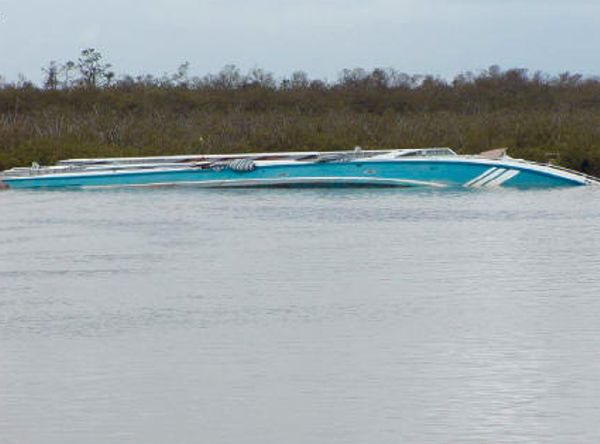
7.15 The Loss of Lives
Due to the very short time between the vessel breaking free from the dock and rolling over, those guests who were still in the salon as the vessel rolled over were thrown from the starboard to the port side. Due to the element of surprise, disorientation and flooding coupled with a sensation of entrapment, death as the result of asphyxiation due to drowning would have ensued in less than two minutes. In his statement, Bart Stanley – Dive Master, described how the guests in the salon "were thrown violently" as well as the feeling of being "trapped." Due to his knowledge of the boat, he swam trying to find a way out, finally exiting from the "starboard exit door facing the wheelhouse." Not being in the salon area proper, he had not been thrown violently and was therefore more able to concentrate his efforts for survival. Also, the Master had described how he had "dived back down to try to open the salon door, but could not open it."
7.18 Captain Philip Martin
Despite his thoroughly commendable efforts in the rescue operations as well as the fact that he was unfortunate in having to deal with a demanding situation so early in his career and during his first tour of duty as Master, we are nevertheless of the opinion that Captain Philip Martin failed in the areas described in 7.7, 7.8, 7.10, 7.14.3, 7.14.4 above. "Consequently, we will be submitting a copy of this Report to the U.K. Maritime & Coastguard Agency as well as to the issuing authority of his Certificate of Competence in the U.K., namely, the Royal Yacht Association/Department of Transport Marine Directorate." In the meantime, he is banned from serving on any vessel registered in Belize pending our being notified of the outcome of the decision by the U.K. Maritime Coastguard Agency and our subsequent review of that decision.
7.19 2nd Captain Frank Wouters
Despite his excellent performance in the rescue operations, 2nd Captain Frank Wouters may be criticized for his failure to monitor properly the weather forecasts on 7th October referred to in 7.7 above. Even though the responsibilities for monitoring the storm/hurricane may not have been clearly defined by the Captain, having assumed that burden, 2nd Captain Wouters should have continued the monitoring of it until such time as he had transferred that responsibility back to the Captain or to someone else designated by the Captain. He also failed to man the wheelhouse after he had ascertained the extreme weather conditions and the need to order the starting of the engines "as a precautionary measure" referred to in 7.14.4 above. Despite the aforementioned failings, he did take due note of the weather information given to him by the catering staff who had been listening to a local radio station and had tried hard to convince the Captain to proceed to Belize City on the night of 7th October in order to disembark the guests. However, due to the failings ascertained, he is banned from serving on any vessel registered in Belize for a period of five years from the date of the issuance of this Report.



All
contents of this site © 2005 Milly Armao, except where
otherwise noted.